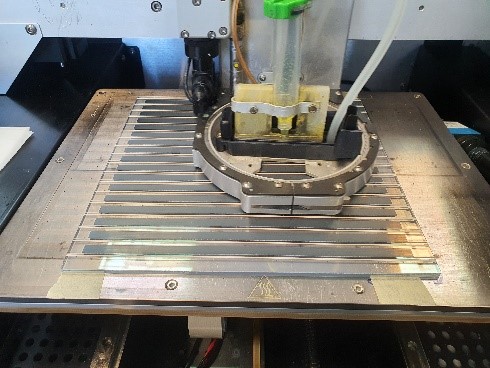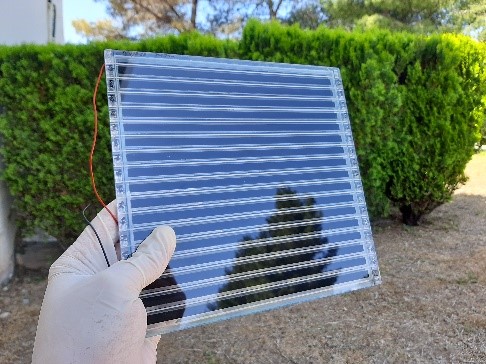Bilateral cooperation between Greece and Germany
«Co‐financed by the European Regional Development Fund of the European Union and Greek national funds through the Operational Program Competitiveness, Entrepreneurship and Innovation, under the call “title: Printed Perovskite Modules for Building Integrated Photovoltaics” (project code: Τ2ΔΓΕ-0560/ 5030132)»
Brief description of the Project
The two main goals of this program were first: to advance the fundamental knowledge in a new and promising technology of photovoltaic (PV) systems that are based on a new material “perovskite”. Secondly, it was to develop a low-cost, scalable methodology that will enable the creation of innovative products from laboratory-type small perovskite PV cells, to larger PVs. The cells will be entirely fabricated with low-cost printing methods with the ultimate goal of application in buildings (BIPV).
Perovskite PVs have the potential for even higher efficiency and very low production costs. However, in order to exploit this advantage and develop new acceptable products on the market, key challenges that were finally addressed and which were the priority of the present project were the following. A better understanding of the properties of the materials and the operating mechanisms of the corresponding PVs, the toxicity of current perovskite PVs (resulting from the presence of lead in the perovskite base material), and relative instability. Especially degradation had been observed during exposure of the PV cells to ambient humidity and exposure to UV radiation, a methodology for gradually transferring the technology from small lab-style cells in low-cost PV arrays. In this project, there was a synergy between the research groups and the involved companies to meet the above requirements focusing on the use of printers for the development of PVs, an advantage that has already been exploited by the Greek company for the development of PVs of similar technology. This technology is believed by all partners to contribute to low-cost PV arrays and ultimately lead to the development of innovative and customized products.
The project partners are committed to an integrated approach to the research on the materials to be used, to the development of the technology in the direction of low-cost, high-performance, non-toxic and stable PVs, as well as their direct utilization by the SMEs involved in the BIPV market.
Objectives and final output from the project
The constructive collaboration of two research groups: University of Peloponnese/Karlsruhe Institute of Technology, with two high-tech companies: Brite Solar from Greece and Sunovation from Germany led to the creation of perovskite photovoltaics in large dimensions using the inkjet printing technique. At 42 months, we consider the project successfully completed as the research team is able to present perovskite PV prototypes with dimensions of 20×20 cm2. Brite Solar as a partner company gained significant expertise in this emerging technology with the cooperation of other partners, while an efficient PV array was fabricated from perovskite by printing methods in a fully uncontrolled environment (i.e. uncontrolled humidity, temperature, inert atmosphere, etc.). This method provides the guarantees that this practice can eventually lead in the future to a product with little investment in its implementation, contrary to what is usually proposed so far internationally where there is a large initial capital/investment for their implementation as they state in fully controlled atmosphere conditions. This structure and application technique is the world’s top choice in perovskite photovoltaic technology, and the project is already having a significant impact as many foreign material companies have expressed interest in working with Brite solar, which has finally implemented large-scale PV.
Inkjet printed perovskite solar modules

Image of a Perovskite solar module in 20×20 cm2 area




